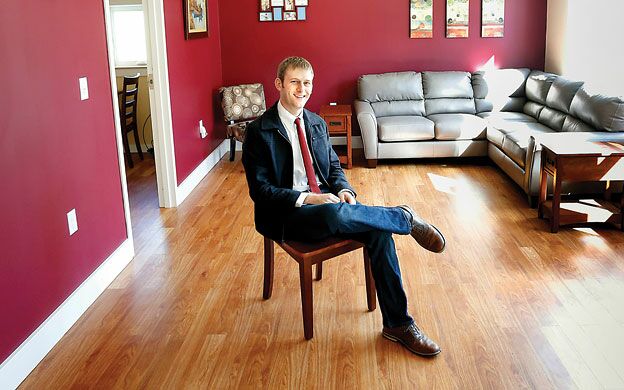Architects embrace new designs for memory care facilities
 PHOTo / Tim Greenway
Evan Carroll of Bild Architecture sits in a recently completed group home in Portland. The facility for adults with intellectual disabilities incorporates many of the same design approaches gaining favor in assisted living facilities.
PHOTo / Tim Greenway
Evan Carroll of Bild Architecture sits in a recently completed group home in Portland. The facility for adults with intellectual disabilities incorporates many of the same design approaches gaining favor in assisted living facilities.
Two years ago, Portland architect Evan Carroll spent nine days at the Maine Veterans' Home in Scarborough, splitting his time between the facility's dementia and rehabilitation units. The then-29-year-old Carroll's stay was part of an effort to learn more about the needs of a population that is expected to grow rapidly in the next decade in Maine: older adults with memory loss.
“It's promising from a business standpoint and it's something that I can get excited about,” says Carroll, who with his wife, Sasha Salzberg, founded Bild Architecture in 2011. It's a niche where Carroll thinks his company can find success.
The state's population trends presage a clear need to increase the amount of suitable housing for people whose memory loss makes staying at home unsafe. Maine's changing demographics also come into play as architects and housing providers rethink their design approaches to meet changing demands from an upcoming generation of assisted living residents. In general, that means designing facilities that feel more like a home than a hospital, says Carroll.
The need to update designs comes from a growing body of research identifying aging and decline as two separate stages of life, each with its own level of care. Studies have revealed new insights about design elements — like lighting, color and corridors without dead ends — that create more comfortable living spaces for people with memory loss.
Another aspect driving that change is more visceral.
“Baby boomers are seeing their parents in some of the current institutions and they are sick to their stomachs,” Carroll says.
Carroll is not the only architect in Maine who declares that the “institutional model” for assisted living and nursing facilities is dead.
“Older nursing homes... they're a long corridor where you can hardly see the door at the end. That's going to be gone,” says Stan Gawron, a principal at Gawron Turgeon Architects in Scarborough.
Gawron's firm has decades of experience in designing for senior living, starting with The Highlands in Topsham, in 1985. Since then, Gawron estimates the firm has designed about 50 senior living projects, a specialty that makes up around a quarter of the firm's business. Along the way, Gawron has noted clear changes in the design approach.
New facilities and renovations of old facilities, he says, are built with a smaller scale in mind, “short corridors, daylight, spaces that open up, little gathering points along the way,” Gawron says. “It's an incredible change.”
Patrick Costin, president of the Portland Society for Architecture and a past board member of the Scarborough retirement and assisted living community Piper Shores, says he expects more firms will look to memory care design in the coming years.
“For firms in general, for the architecture profession, the need for design services related to memory care will, I think, grow,” says Costin, who is a principal at the Portland-based Canal 5 studios.
In the next decade, people 65 and older are expected to make up almost all of the state's population growth, according to a 2012 population trend study by the Muskie School of Public Service. The study projects Maine's senior population will grow by 105,000 by 2022, while the under-65 age group is expected to add just 1,565 in the next 10 years.
Within that older population, memory-impairing diseases like dementia and Alzheimer's are becoming more common. The Maine chapter of the national Alzheimer's Association projects the number of people with Alzheimer's will rise from 37,000 to more than 53,000 by 2020.
The demand for memory care services in the Portland area is enough for the Massachusetts-based Northbridge Cos. to open a standalone memory care facility with 70 apartments in Westbrook. The Avita on Stroudwater facility, designed by Rebecca Dillon at Gawron Turgeon, is the company's first in Maine and it follows a memory care model the company developed more than two years ago, emphasizing smaller scales to replicate the feelings of a home, not an institution.
On a recent tour, Liz Leonard, the company's marketing director, pointed out that the facility is split into three distinct “neighborhoods” of just over 20 residents. Each neighborhood has its own “country kitchen” dining area.
Indeed, tucked into the counter of what looks like a residential kitchen are three buffet-style warming units.
“[Staff] will plate things and even cook things right there, because the sense of smell is important for memory care,” Dillon says. “It actually stimulates the appetite, so when [residents] can smell it and see it and hear it being cooked, they tend to eat more and eat better.”
Through each seasonally themed wing of the building, other research-based design elements are apparent, like the use of natural colors. There's easy access to an outdoor courtyard that promotes activity and a garden that also provides sensory stimulation.
The design also incorporates elements geared toward families of residents, like a small cafe area where people can access the Internet — a feature intended for adults needing a place to complete work or to give visiting children an avenue for diversion.
That homey-feel is a selling point for Northbridge Cos., says Leonard, as families struggle to find suitable placements for aging members of the family who need more care than what can be provided in their homes. Leonard says Avita on Stroudwater targets clients with early- to mid-stage memory loss from dementia or Alzheimer's. By mid-October, the month of its opening, it had filled nearly one-third of its apartments. A similar 36-apartment Falmouth project that broke ground in September had filled half of its inventory by the same date.
A market in transition
Victor Regnier, a professor of architecture and gerontology at the University of Southern California, estimates that around 80% of the assisted living business will eventually be made up of memory care services, according to the Assisted Living Federation of America. Broadly, he says, nursing homes are being replaced by assisted living facilities for certain populations.
Apart from Regnier's projections, the numbers of residents at Maine's nursing home facilities, which provide a higher level of medical care, has declined steadily since 2000, while the number of people in assisted living facilities has risen. The Muskie School study estimates the average monthly number of people in assisted living facilities in Maine grew by 30% from 2000 to 2008. During the same period, the average monthly number of people in nursing homes declined nearly 14%.
The opening of a market for that specific clientele means an opportunity for architecture firms to improve design elements that research has tied to specific outcomes in the health and well-being of residents.
For example, “You never design a building so there's a dead end,” Dillon says. “[Memory care] residents get agitated if they get stuck at the end of a corridor.”
Costin says his experience at Piper Shores indicated that future design work will require a collaborative approach that incorporates input from health care providers, caregivers and social workers who can provide insights into the needs of the family.
Carroll of Bild Architecture hopes his immersion work at the veterans' home two years ago will help him land a bid he's submitted on an expansion at the Park Danforth facility in Portland.
“There's absolutely a need to redesign [assisted living facilities],” Carroll says.
Read more










Comments